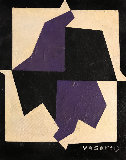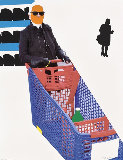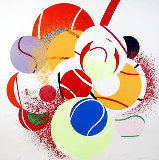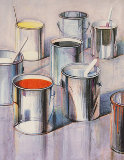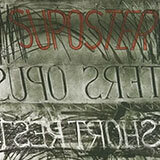






Untitled (Paris Review)
Sol LeWitt
Limited Edition Print : Screenprint on Heavy Wove Paper
Size : 40x30 in | 102x76 cm
Framed : 44x34 in | 112x86 cm
Edition : From the edition of 100
-
🔥Fabulous Framed Screenprint - Blue Chip - 2 Watchers $$$$$$$
Year1983
Hand SignedHand Signed in Pencil Lower Right
Condition Excellent
Framed with GlassNatural Wood Frame.
Purchased fromAuction House 2014
Provenance / HistoryA four-by-four grid of large, colored squares. The squares are filled with colored lines. The colors range from reds, blues, yellows, and greens to greys, including a white square in the bottom right corner which contains the words The Paris Review.
Story / Additional InfoScreenprint in colors, on heavy wove paper, with full margins. Published by the Paris Review, New York. From the signed and numbered edition of 100.
Certificate of AuthenticityArt Brokerage
Additional InformationMotivated
LID73737
Sol LeWitt - United States
Art Brokerage: Sol LeWitt American Blue Chip Artist: b. 1928-2007. Sol LeWitt was born in Hartford, Connecticut in 1928, the son of Russian Jewish immigrants. He was raised by his mother and his aunt following his father's death when he was six. As a child, he enjoyed drawing on the blank sheets of wrapping paper in his aunt's store and attending art classes at the Wadsworth Atheneum. LeWitt completed a traditional art program at Syracuse University in 1949 and served in the Korean War as a graphic artist. In 1953 he moved to New York and held a variety of short-term jobs, including working as a night receptionist at the Museum of Modern Art, while developing alternatives to what he called "the useless ideas of Abstract Expressionism." He began making simple geometric paintings in series, which became the basis of his art. In the early 1960's, LeWitt extended these ideas to three- dimensional wooden forms or "structures." Bothered by their inconsistencies, he stripped the wooden skin off these structures to reveal the sculpture's skeletal core. He also developed a prescribed ratio that he followed, which determined the amount of open space versus the amount of support structure in each piece. This focus on highly conceptual relationships, with increasing complexity and variation, has continued to guide his work as a sculptor. The cube provided a particularly rich form for this kind of exploration and has been the focus of his attention for decades. He has been equally concerned with expanding the parameters of two-dimensional work, creating drawings and paintings that are applied directly to the wall and that transform entire architectural environments. Listings wanted.




